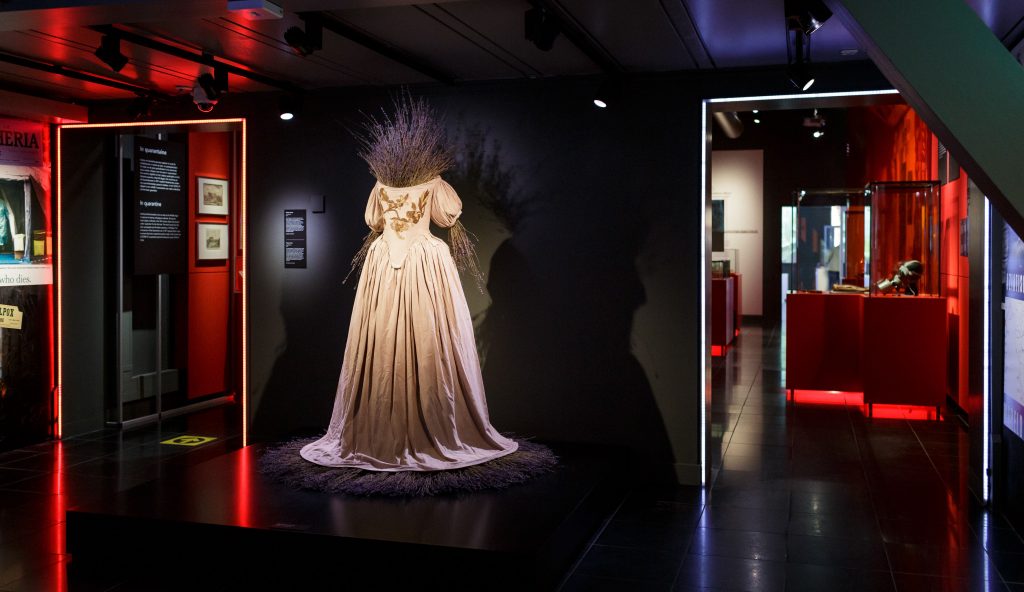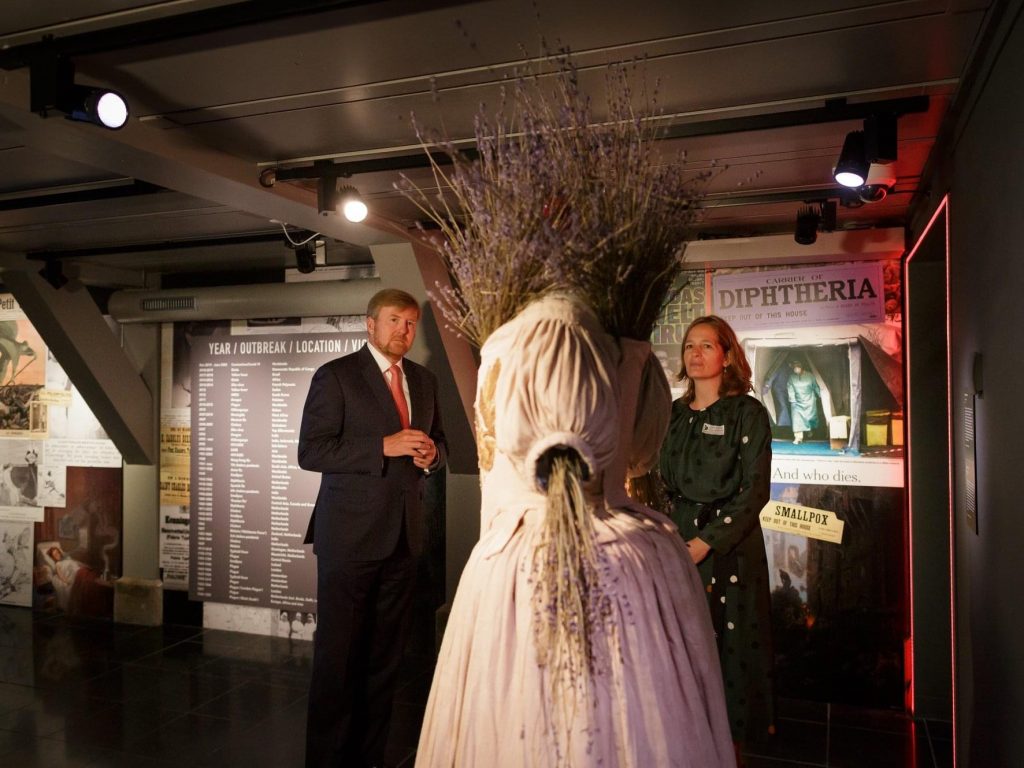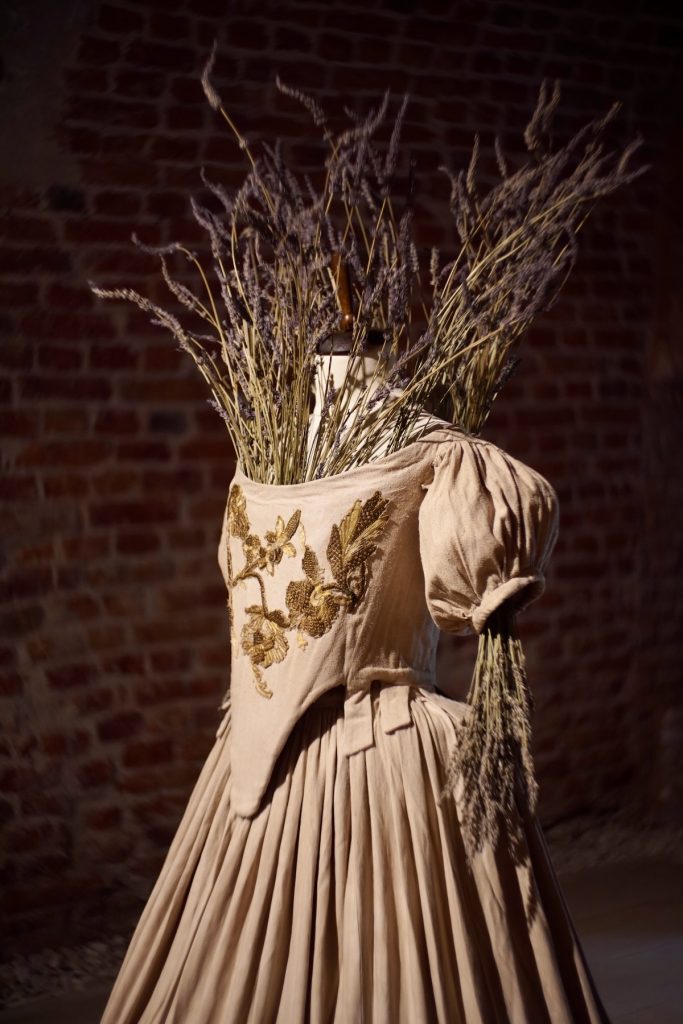This 1665 style “Plague Dress” (2018) is made from raw silk, hand-dyed with walnut husks in reference to the famous herbalist of the era Nicholas Culpeper who recommended walnuts as a treatment for Plague. The dress is appliqued with original 17th century embroideries which Anna Dumitriu has impregnated with the DNA of Yesinia pestis bacteria (Plague), which she extracted from killed bacteria in the laboratory of the National Collection of Type Cultures (NCTC) at the UK Health Security Agency (formerly Public Health England) where she is artist in residence. The NCTC is the oldest and most historical collection of pathogenic bacteria in the world.

The dress stuffed and surrounded by bunches lavender which were historically carried under people’s noses during the Great Plague of London to cover the stench of infection, and prevent the disease, which was believed to be caused by ‘bad air’ or ‘miasmas’ .

The roll, a piece of padding typically worn under the skirt to puff it out, contains a pungent mixture of herbs and spices that would have been stuffed into beak-like masks of Plague doctors.

The silk that the dress is made of references the Silk Road link, but also the fact that the first and worst affected tradespeople to suffer in the Great Plague of London were the cloth workers who received the imported fine silks and linen. Almost everyone in that period knew of stories of Plague entering communities by cloth, especially light coloured fabric, a famous example being the ‘plague village’ of Eyam in Derbyshire, UK, where the pestilence arrived via the village tailor on a bundle of flea infected cloth from London.

The trauma of the Plague on humanity has been huge, but its impact on our societies can still be observed today in our public health strategies and local government infrastructures. However, we still need to be vigilant as poverty and lack of clean water are huge risk factors for this ancient disease, which in 2017 was found to be resistant to two of the antibiotic drugs normally used to treat it. Dumitriu also worked with Rosie Sedgwick to construct the dress.
Exhibitions

“The Plague Dress” premiered as part of the 6th Guangzhou Triennial As We May Think, Feed Forward at Guangdong Museum of Art, China at Guangdong Museum of Art, from 21st December 2018 to the 10th March 2019. It is particularly relevant to connect the cities of Guangzhou and London as both cities have suffered extensively from Plague. The second Plague pandemic which was responsible for the Great Plague of London is 1665 is believed to originated in the rodent population in or near China and was most likely spread along the Silk Road or by ship, perhaps even via Guangzhou which was a key trade port on the maritime Silk Road. Later the third Plague pandemic killed 60,000 people in Guangzhou in just a few weeks beginning in March 1894.

The Plague Dress was part of a major exhibition entitled Contagious! at Rijksmuseum Boerhaave, Netherlands. It was a particularly suitable location for the work as the museum was formerly a ‘Pest House’ for the care of Plague victims and holds van Leeuwenhoek’s microscopes, through which he observed bacteria for the very first time, in their collection.

Contagious! was opened by the King of the Netherlands on 16th July 2020, and continued until 7th August 2022. Check the website for opening times and COVID measures. There is also a 360 degree virtual tour of the show.

The Plague Dress was part of BioArt Alchemy, a solo exhibition which took place from the 16th September – 30th October 2022 at Spazju Kreattiv in Valletta (Malta).

The Plague Dress was part of BioArt Revolution/ Revoluția BioArt, an innovative solo exhibition by Anna Dumitriu which brought together contemporary artistic approaches and modern scientific experiments to address issues of global relevance such as infection, climate change, and diversity took place as part of Timișoara 2023 European Capital of Culture, from 30th September to 1st October 2023. The exhibition, which was created in collaboration with the Romanian Science Festival, took place in the stunning setting of Bastionul Maria Theresia, Galeria 2, Str. Hector, nr. 1, Timișoara, Romania.
The Plague Dress was part of BioArt Knowledge: A Solo Exhibition by Anna Dumitriu at the Yarrow Gallery in Oundle, Near Peterborough, UK, from 9th November – 6th December 2023.

The Plague Dress was part of Fragile Microbiomes (solo exhibition) at the Thackray Museum of Medicine, Leeds, UK, from 10th February to 23rd June 2024.
